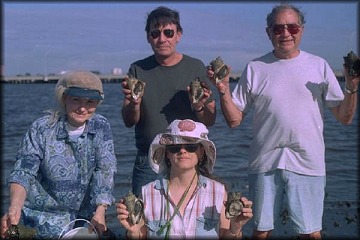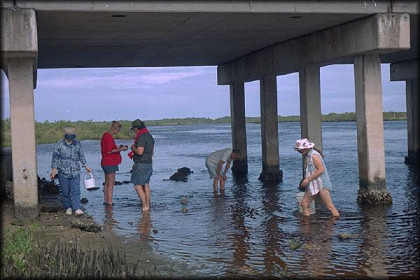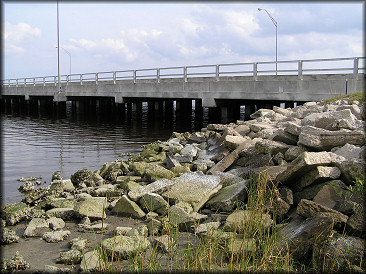|
|
|
|
Oversize Melongena from the Halifax River |
|
|
(Pictured left to right are Betsy Lyerly, Bill Frank, Mary Reynolds, and Bill Lyerly.) |
|
|
With the aforementioned in mind, JSC members decided to return to the Daytona Beach area to see what time had wrought in regards to the Melongena population and whether the massive specimens were still present. So, the morning of Saturday, March 28th, seven club members (Charlotte, Mary Reynolds, Bill and Betsy Lyerly, D. D. and Rob Jewell, and your Editor) assembled at the Denny's Restaurant at Baymeadows Road and Interstate 95 to caravan to the area in question. While seven members started, it might be mentioned that Club Vice-President D. D. Jewell was nine months pregnant and we are thankful that ultimately only seven club members returned to Jacksonville. Despite this lack of a birth during the trip, the future proud parents insisted that this was their new babies first shelling trip. The first stop was a Burger King in Port Orange - but not for shelling. Your editor, acting as navigator, carelessly got the caravan in a right-turn only lane and there was nothing we could do at the last minute. Oh well, everyone needed to visit the facilities anyhow! The second stop was Rose Bay - a Melongena collection locality Charlotte had visited during her previous trip. Unfortunately, despite being one of the lowest minus tides thus far during 1998, the tide just did not go out as predicted. An stiff on-shore wind was probably a contributing factor not to mention the difficulty of accurately predicting tide heights for these sinuous backwater areas. Despite this drawback, the group managed to collect a good selection of the Melongena corona sprucecreekensis forms. The next stop was Spruce Creek; the type locality for Melongena corona sprucecreekensis and the collection locality of Charlotte's 201 mm. specimen. Plenty of dead specimens were found but relatively few live ones. Again the reluctance of the tide to "go out" somewhat hampered collecting. |
|
|
|
|
|
Under the Spruce Creek Bridge |
|
|
(Pictured left to right are Betsy, D.D. Jewell, Bill Frank, Bill Lyerly and Mary.) |
|
|
|
Dunlawton Bridge, Halifax River, Port Orange |
|
The last stop was at what we will call "Charlotte's Melongena spot" in the Halifax River - the location where large specimens of both forms had been collected some 10 years earlier. Things had not changed significantly. Interestingly, the two forms observed by Charlotte previously were still present in large numbers feeding side-by-side on the plentiful oyster bars. However, while the Melongena corona sprucecreekensis forms were not particularly large, specimens of the squat chunky form approaching 7 inches in length (175 mm.) were found with 6 inch specimens (150 mm.) being the norm. Had the tide been lower and the persistent wind not roiled the water limiting visibility to about one foot, it seems likely that even larger specimens would have been found. As it was, the groups collecting was limited to a relatively small area. After dinner at the Cracker Barrel in Daytona Beach, it was back to Jacksonville - happy with the days collecting. A follow-up visit to the area was made by your editor, Phil Poland, and Marlo Krisberg (Melbourne) on March 24th. Charlotte's Melongena spot was again visited and many very large specimens were found. Interestingly, similar oyster bar habitats less than a 1/4 mile away contained an equal number of Melongena but most were not particularly large. At both locations the shells were busily breeding. The largest specimen found was 177 mm. in length. Based upon the outlandish size of the Melongena found thus far in the Halifax River and Spruce Creek under less than optimal collecting conditions, it appears likely to this scribe that the new world record Melongena corona is there just waiting to be discovered. Maybe we will find her on the next trip! |
|


